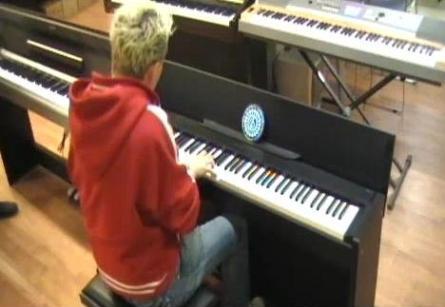
Piano Keyboards Buyers Guide: This is the place where you should begin to know more about keyboard instruments.
Earlier, cost would be deterrent as a piano was expensive compared to other instruments. But today, with so many options affordable available in electronic keyboards, it’s a great time to start playing the keyboards. In case you’re looking for a digital piano or music keyboard, this is the place to start.
Music Keyboard & Digital Piano: Features
Piano/Keyboard: Various Types
A piano can come in various looks – upright, grand piano or the simple portable piano look, each targeting a different set of piano players.
Grand Pianos: In the acoustic version, the strings are laid horizontally to the ground (the vibrations are directed upwards). Concert grand pianos tend to be much larger (most are around the 9′ mark). Baby Grand pianos are smaller than the grand pianos but similar in shape and structure.

Grand piano vs baby grand piano size
In Upright pianos, the strings are vertical in position. Sound is good but the richness of the sound is not as good as on a grand piano.
These vary in heights; tallest vertical pianos are ‘Upright pianos’, then the ‘Studio Pianos’, then comes the ‘Console Pianos’, and the shortest are the Spinet Pianos.
Digital Pianos vs Acoustic Pianos
Until a couple of decades back, acoustic pianos were commonly used, but buyers today feel they are no longer practical and prefer digital pianos instead.
Digital pianos are affordable, compact and portable (compared to acoustic pianos) and also do not require tuning or lot of maintenance.
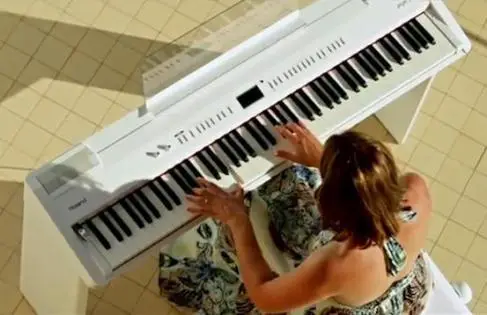
In an acoustic piano, sound is produced by hammers that hit the strings. On a digital piano however, the sound is produced using sound samples that are stored digitally on the instrument, which are then triggered through the keys.
Most digital pianos now also replicate the actual acoustic piano action.

An upright console digital piano (also known as Home digital piano)
Digital pianos are available as portable pianos, and also in traditional piano look (as upright and grand piano). Upright digital pianos (console, spinet or portable versions) are compact and require less space.
Digital pianos now have all the features of a musical keyboard – rhythms, different instrument voices, on-track sequencer, effects, etc. You can connect headphones for silent practice. A digital piano is also able to communicate with other music hardware/software.
Related: There are several musicians who Toy pianos for professionals.
Types of electronic/digital keyboards
Digital keyboard instruments make use of sound samples. There are various kinds/types of digital keyboard instruments such as arranger keyboards, synthesizers, workstations, midi-keyboards, and digital pianos. They may further vary depending on the number of keys and other features.
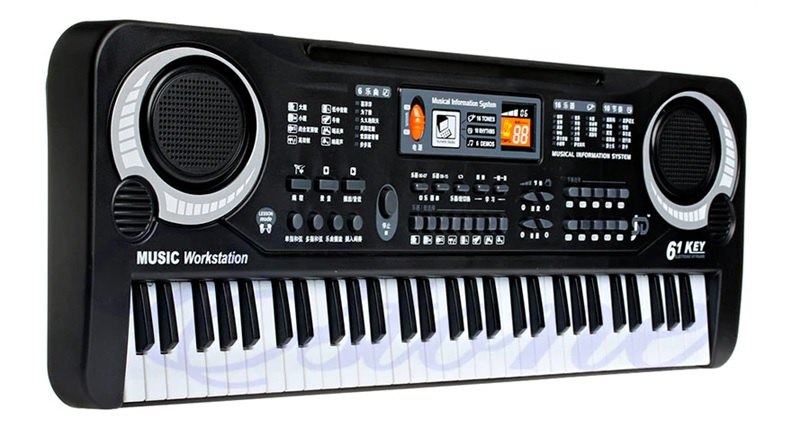
Electronic Keyboard (Arranger Keyboards)
These keyboards are lightweight, portable inexpensive musical keyboards with built-in accompaniments that are perfect for home use. These music keyboards are best suited for beginners (although you get models for intermediate/advanced players as well).
These are also known as arranger keyboards (or ensemble pianos) as they come with built-in rhythms (also known as styles/accompaniments). You can add interesting arrangements by using buttons such as Start, Stop, Intro, Ending and Fill-ins. These keyboards have built-in speakers, and are loaded with several sounds, rhythm patterns, and built-in songs to help you learn to play.
Digital Piano
These come with weighted keys and are available as portable pianos and pianos with traditional (classic) looks. These may or may not come with built-in rhythms.
Synthesizer & Music Workstation
Synthesizers are used mostly by working musicians for gigs. Music Workstation is used for performance as well as for music production. It is a portable studio and is designed for professionals. It’s a synthesizer, sequencer, sampler, and music keyboard, all rolled into one.
MIDI controller Keyboard
These do not come with a built-in sound engine. They do not have the capability to produce any sound from within; they just inform the computer (or any other sound-generating hardware equipment) what note needs to be played/recorded and the computer generates the sounds. These are used by composers for music production.
Key Action, Touch-Sensitive Keys
Types of Keys (Action) on Keyboard Instruments
The keys of a keyboard instrument can have different kinds of action, such as not-weighted, semi-weighted, fully-weighted, wooden action, etc.
- Various piano key actions – Synth, Weighted, etc
- Touch-sensitive (velocity-sensitive) in keyboards explained
What is Polyphony?
Polyphony refers to the maximum notes that can be played by the digital keyboard/piano simultaneously. So if a keyboard has a polyphony of 4 notes, maximum four notes can be played together at one time. This includes the notes you press, the notes comprising the accompaniment, pedal press, layered sounds, etc. (these all count towards the maximum allowed notes).
If you pressed more keys (than the maximum limit), you will hear notes dropping out while you play. Once you reach maximum polyphony, the keyboard will not play any additional notes that are played until older notes are released. Notes dropping of is commonly observed when complex passages with chords are played, along with different voices and accompaniments.
The keyboards of today have more polyphony (32 notes, 64 notes, and more). Most beginner keyboards have 32 notes polyphony and its more than enough for beginners.
Advanced players however should opt for keyboards with at-least 64-notes as they are likely to play complex chords, use features like split/layering, etc. Besides, the styles on such keyboards (better ones) are also more realistic. So for better playing experience, advanced keyboards (with styles) should have at least 64 note polyphony.
However, you could still buy a digital piano with 32 notes polyphony, if its doesn’t come with built-in styles.
Digital Piano Keyboard: Input, Output, Jacks, Connectors Explained
Music keyboards and digital pianos have a number of inputs and outputs (accessory jacks and connectors) which you can use for different uses.
Some keyboards also have options for expansion and to write to external storage devices such as smart cards.
Power/DC-In Jack: This is where you connect the power adapter to power up your keyboard.
Headphones
On most keyboards this output is named as Phones/Output. You use this output to connect your headphones or to connect to external amplifiers.
Line Out (Output)
You can send the output of your keyboard to Headphones, Speakers, Amplifiers, stereo system and Mixers. “Phones / Output’ connector is commonly available that is used to make this connection.
Audio In
You can connect mp3 player or an external sound module to your keyboard/Digital Piano using this input. This input is also known as “Line in” on some instruments.
Sustain Pedal Jack
This jack allows you to connect an optional sustain pedal to emulate the pedal on a real piano. On some keyboards this may be labelled as Damper or sustain. This is a great accessory to have if you are keen to take piano lessons.
Microphone
Many keyboards now feature a microphone input that lets you connect a mic and add voice or any acoustic instrument.
Host/Computer
Some keyboards can be directly connected to the Computer using the connector called “to host” or “Computer” slot. This is usually a USB slot which allows you to easily make the connection to a computer.
MIDI
Use this to connect your keyboard to a computer, and use music learning or music composition software. Most recent keyboards allow midi connection via USB but in older models, you had MIDI In/Out jacks for making this connection.
Buying a Piano Keyboard
Top Brands
Popular brands include Yamaha, Casio, Roland, Korg, although several new brands have emerged in the last few years, especially in the entry-level segment.
While the new brands make cheaper beginner keyboards, the overall sound quality tend to be okay on these keyboards, and many of them also do not offer touch-sensitive keys.
For keyboard instruments with better sounds and features and more durable products, you will have to consider the more trusted brands like Yamaha, Casio, Roland, Korg.
Both, Yamaha and Casio have a wide range of keyboard instruments.
Other brands like Roland and Korg have several high-end pro keyboards in their keyboard portfolio. They also offer a wide-range of digital pianos (portable as well as home pianos).
What Should Beginners Buy?
Beginners (young or adult) should ideally opt for a keyboard with touch-sensitive keys, or a piano with fully weighted keys.
It is recommended that you buy a keyboard with at least 61 keys (and touch-sensitive keys) if you’re serious about playing the keyboards. So, a 61-key (5-octave) keyboard would be ideal to start on.
However, if you intend to play a lot of piano pieces, you need one with weighted keys and preferably a keyboard with more than 61 keys.
If you’re serious about the piano, get a 88-key weighted digital piano (or even a piano with 76 keys if budget is a constraint).
Buying a Music Keyboard/Digital Piano
Consumers today are spoilt for choices; there are various types of keyboard instruments available from various brands. Every keyboard-instrument is built for a purpose.
The various factors that you need to consider before buying digital keyboard instrument includes things such as cost, your skill-levels, musical objectives and features such as number of keys, key action, sounds, styles, recording capabilities, etc.
.Related: Factors to consider before buying a digital piano keyboard
Best keyboards for various price ranges.
- Best Digital Pianos/Keyboards for various price ranges
- Best 61-key electronic keyboards for beginners.
- best piano for kids and adults.
- Yamaha Keyboards
- Casio Keyboards
Number of Keys
Digital keyboards are available in various number of keys.
Mini Size Electronic Keyboards
 Mini sized keyboards are usually available in 37 keys (3 octaves) or 49 keys (4 octaves), and have smaller sized keys. These are designed for the earliest beginners, and do not have touch sensitive keys.
Mini sized keyboards are usually available in 37 keys (3 octaves) or 49 keys (4 octaves), and have smaller sized keys. These are designed for the earliest beginners, and do not have touch sensitive keys.
Portable 61-Key Electronic Keyboards
 You should consider buying a 61 key keyboard (or even a 76-key keyboards) with touch sensitive keys if you are serious about learning. These are perfect for beginners and hobbyists for learning to play the keyboards (suitable for kids as well as adult beginners).
You should consider buying a 61 key keyboard (or even a 76-key keyboards) with touch sensitive keys if you are serious about learning. These are perfect for beginners and hobbyists for learning to play the keyboards (suitable for kids as well as adult beginners).
Lighted keyboards: You also get keyboards with keys that light-up making it easier for you learn to play songs. Beginners (both children and adults) like this feature where the keys light up and wait for you so that you know which key you should be pressing next while learning to play the built-in songs. Checkout the best lighted piano keyboards here.
76-Keys Electronic Keyboards
 You can now even buy 76-key electronic keyboards at entry-level prices. More keys enable you to play more musical pieces (as it has more keys), and there are some real value buys in this category. Despite having 76-keys, they are still lightweight because they don’t come with full-weighted keys (most have unweighted or semi-weighted keys). Nevertheless, do consider these keyboards as well if you’re looking for your first electronic keyboard.
You can now even buy 76-key electronic keyboards at entry-level prices. More keys enable you to play more musical pieces (as it has more keys), and there are some real value buys in this category. Despite having 76-keys, they are still lightweight because they don’t come with full-weighted keys (most have unweighted or semi-weighted keys). Nevertheless, do consider these keyboards as well if you’re looking for your first electronic keyboard.
Keyboards with Weighted Keys
 You get full sized 88 key keyboards with weighted keyboard that are apt for taking piano lessons and for practicing piano.
You get full sized 88 key keyboards with weighted keyboard that are apt for taking piano lessons and for practicing piano.
Best budget 88-Key music Keyboards/pianos (priced around $500)
Accessories, Care & Repair
You’ll need some keyboard accessories to enhance your keyboard playing experience, to keep your instrument safe, and to get the best out of your keyboard instrument.
Though there is a wide range of accessories available for keyboard instruments, to begin with, a keyboard stand for your 61 key keyboard and a good sustain pedal (in case you want to learn piano) is something that you should consider buying.
You may also require headphones or an external amplifier.
You can check out the list of piano accessories & supplies here.
How to take care of your keyboard instrument.
- Piano Care, cleaning, polishing
- Piano Cleaners & Polish Kit
- Digital piano keyboard repair: Solution to common repair problems.
More Keyboard Instruments
Here are other popular keyboard instruments which have been in existence for many years now. These are inexpensive, much lighter, easy to maintain and are non-electronic.
Melodica Pianos
 Popular among music students, the Melodica is an easy to play instrument. Lot of flute players also find it easier to play this instrument. The keys on the melodica are laid down just like those on a keyboard/piano, but this one has fewer number of keys. Read more here…
Popular among music students, the Melodica is an easy to play instrument. Lot of flute players also find it easier to play this instrument. The keys on the melodica are laid down just like those on a keyboard/piano, but this one has fewer number of keys. Read more here…
Thumb Pianos
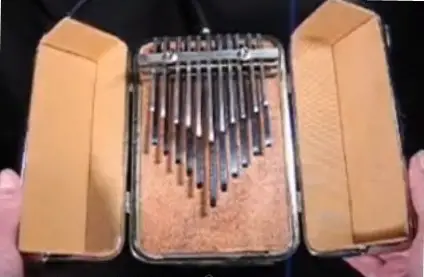 While the keys on a thumb piano (a small sized instrument) may not look exactly like those on a keyboard, its laid down in a similar manner and is quite easy to play. This musical instrument is quite common in African countries. Read more here…
While the keys on a thumb piano (a small sized instrument) may not look exactly like those on a keyboard, its laid down in a similar manner and is quite easy to play. This musical instrument is quite common in African countries. Read more here…
Accordions
For instance, the accordion is such a fascinating instrument that the whole world loves its unforgettable sound. This instrument actually has fans all over the world, and of late has been making a remarkable comeback (in terms of popularity). The accordion can be heard in countless countries worldwide because of its beautiful tonality which makes it perfect for almost any musical genre.
Acoustic Pianos
This is the grand daddy of all acoustic keyboard instruments and also the most popular. Even if you have never played one, you would surely have seen one (at least on television or in the movies). These have 88 weighted keys.
Harmonium keyboard
Harmonium is a popular Indian Instrument that is commonly used by Indian classical singers to accompany their singing. The instrument is widely used for providing accompaniment in devotional songs, folk music and classical music.
The instrument is also commonly used by Music teachers who teach Indian classical music, be it singing or for learning the harmonium (the keys are similar to that on a keyboard, its about 3 to 3 and 1/2 octaves long).
In India, Harmonium is also known as the “Peti or Baja”.
In terms of construction, the harmonium is basically a reed organ with hand pumped pressure bellows that pushes the air through the reeds.
Different types of harmoniums are available – Folding, upright, portable, 2 reed, 3 reed, 4 reed and mini harmoniums, as well as a selection of surpeti (also known as a sruti box or shruti box) and scale change harmoniums.
- Bina 23B kirtan harmonium: Small, portable harmonium with 32-keys. Its small enough to take on an airplane as carry-on luggage.
- Paul & Co. 3 reed scale change harmonium: This is top of the line harmonium. Paul & Co. harmoniums are made under the guidance of Paul Babu (Batta Krishna Paul), probably the best harmonium maker of his times.
- MAHARAJA DB Harmonium: This Mahogany Color harmonium has 39 Keys, and is a popular option, its also cheaper compared to the other options mentioned above.
Acoustic keyboard instruments like the Melodica, Harmonium, and Concertina can also be termed as aerophones because they produce sound by causing a body of air to vibrate, without using any strings or membranes.
More Features on Keyboards
How to Connect a Piano Keyboard to Laptop, Computer, iOS Device
Once your keyboard is connected to a computer or iOS device, you can work with music learning or record music using composition software.
Most latest keyboard models come with a USB MIDI port, in which case all you need is a standard USB cable (connect directly from the keyboard’s USB to the USB port of your computer).
You also get MIDI to USB Interfaces which makes it easy to connect to a computer.
More Features
Split Feature
A music (electronic) keyboard comes with several voices (instrument sounds / patches), but you can still create more interesting voice combinations to enhance your keyboard playing experience.
For example, using the ‘Split’ feature, you can split the keyboard so that you can play one instrument on one side of the split and another instrument on another side of the split. So you can play bass with the left hand, while the right hand plays the melody or chords.
How to Layer Sounds
Layering multiple sounds on a Keyboard is a great way to come up with interesting patches, including getting thicker sounds.
Many digital piano models have limited number of sounds and are designed for piano practice. So you can always layer the piano sounds with other sounds to create more refreshing sounds.
Layering a piano with strings is the most common form of layering that produces a rich sound; but you’re free to try out more combinations to see what you like.
Piano Accompaniment: How to Use Styles
A Style (also known as an Accompaniment) is your Personal backup band. On a typical Music keyboard, you can find various categories of styles such as Ballad, Dance, Disco, Jazz, Country, Latin, Waltz, etc.
You can trigger the accompaniments in an electronic keyboard instrument by playing the chords in different modes: single finger mode, fingered mode and full fingered mode.
- Single Finger mode: You need to press only one note i.e. the key note of the chord to trigger the accompaniment section.
- Fingered: You need to play all the notes of the chord to trigger the accompaniment section.
- Full Fingered: You can play the chord anywhere on the keyboard and the accompaniment section will recognize it and start playing.
Almost all the types of chords are recognized by an electronic musical instrument.
Record songs & styles using sequencer and recording functions on music keyboards
Most keyboards come with a built-in sequencer (built-in recorder) that lets you record your musical ideas, which can then be played back on the instrument.
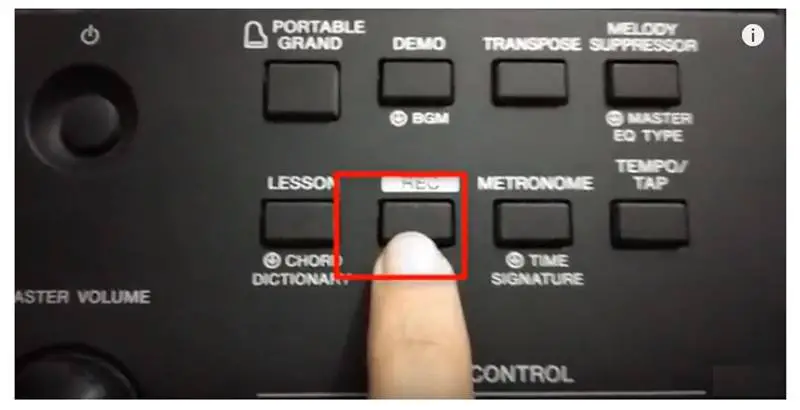
Recording is very easy; just press the Record Button and the sequencer will record whatever you play. If you want to hear back your recorded song, you just have to hit the START button. You can record anything – you can either play solo, or you can select your favorite style and then play on top of it. Your song will be recorded and save on the keyboard.
The top keyboard models come with 16-track sequencer and comprehensive editing features so that you create complex arrangements. 16 tracks mean you can actually use few tracks for drums and bass, few tracks for chord instruments, which still leaves you with more tracks to add instruments as per your choice. Usually, boards with 16-track sequencers also have a higher polyphony so that you don’t run out of notes when creating complex arrangements.
Mixer Feature on Keyboards
Any song would typically have the following instruments playing together.
- Rhythm – Drums or some rhythmic pattern
- Bass
- A couple of guitars or piano for playing chords
- Pads
- Melody
The mixer function on an electronic music keyboard allows you to control different parameters related to the musical instruments in a song. Some of the parameters that you can control include – tone, volume, pan position, etc. for each built-in auto accompaniment part and each track recorded with the song sequencer.
With the help of the mixer on your music-keyboard, you can also study how the various built-in musical styles are created. Begin with drums; add bass to it; then add the chord tracks and finally the main tone. See how all the tracks sound together finally.
Leave a Reply